Nakaoki Tea
In Japan, in October, the Shin-tō kami, 神道神, God-way gods, assemble at I-zumo Tai-sha, 出雲大社, Out-cloud Great-shrine. This event gives rise to the 10th month being called Kan-na-zuki, 神無月, God-less-month. This is true throughout Japan except in Izumo area when is called Kami-ari-zuki, 神在月, Gods-are-month.
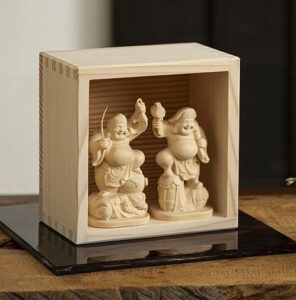
Carved figures of Dai-koku-ten, 大黒天, Great-black-heaven (Deva), and E-bi-su-te, 恵比寿天, 恵比寿, Bless-like-longevity-heaven (Deva), displayed in a (rice) masu, 升, box measure; souvenir of I-zumo Tai-sha, 出雲大社, Out-cloud Great-shrine, Izumo City. Ebisu is a god of wealth and fishermen. Both Daikoku and Ebisu are worshipped together at Izumo Taisha, especially by couples wishing for a happy wedding. Daikoku and Ebisu are two of the extremely auspicious group of Shichi-fuku-jin, 七福神, Seven-fortune-gods.
Tō-kan-ya, 十日夜, Ten-day-night: is a harvest festival held on the night of the tenth day of the tenth month (to send the rice paddy gods back to the mountains after harvest). Wordplay on tōkanya, 当館や, merchant-hall, Ebisu is worshiped by merchants for success in business. Tōkanya is observed primarily at Izumo Taisha, with a dance performed by a character as Ebisu. This is curious, because Ebisu’s partner Daikoku is the god of rice. Traditionally, Tōkanya is observed on the 10th day of the lunar 10th month.
According to Chanoyu tradition in the tenth month, the fu-ro, 風炉, wind-hearth, is moved to center of the tatami where tea is prepared. This manner of presentation is called Naka-oki, 中置, Middle-place, which has roots in Buddhism, which is appropriate, as the Buddhist deities remain in their altars. It is only the Shintō deities that have left their shrines. The gods gather to decide on the future of the Japanese people. Besides the main shrine, there are eight secondary shrines on the sacred grounds.
Chanoyu continues quite often presenting the Nakaoki with incense and homage to Amida, the Buddha of Compassion. The following utensils are to honor the Shintō kami, with special emphasis on the principle deity of Izumo Taisha, known as O-kuni-nushi-no-mikoto, お国主命, Hon.-country-master-lord. He is called by many names, and is later is more familiarly known as Dai-koku-ten, 大黒天, Great-black-heaven (Deva). An earlier form of Daikoku is Mahākāla (Great-black), and is remotely identified with Shiva, Lord of Destruction.
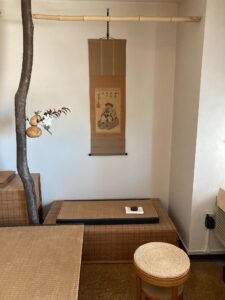
Garandō tokonoma with kake-jiku, 掛軸, hang-scroll, with an image of Dai-koku-ten, 大黒天, Great-black-heaven, with his hammer and treasure bag standing on two kome-dawara, 米俵, rice-bale. Daikoku is a god of rice and wealth. Kake hana-ire, 掛花入れ, hang flower-receptacle, aged, natural gourd.
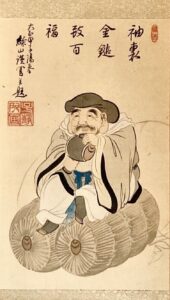
Picture of Daikoku; with calligraphy, Sode-ura Kin-tsuchi tsuzumi hyaku-fuku, 袖裏金槌鼓百福, Sleeve-lining gold-mallet source hundred-fortune. Dated Tai-shō Kinoe Ne, 甲子, Wood’s older brother Rat, 1924.
The Japanese phrase for the drumming of Daikoku’s mallet bringing fortune inside the sleeves is:
大黒の小槌の音、袖に福来る
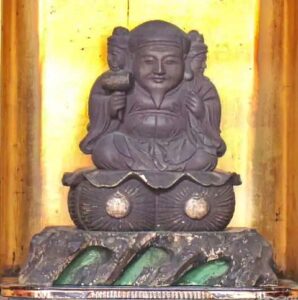
Daikoku is one of the gods revered at Shi-ten-no-ji, 四天王寺, Four-heaven-kings-temple, during the Autumn festival of Hi-gan, 彼岸, Other-beach, in Ō-saka, 大阪, Great-slope. An image of the Sanmen Daikoku is the central deity. The other two faces are of Bi-sha-mon-ten, 毘沙門天, Attend-sand-gate-heaven (Deva), and Ben-zai-ten, 弁財天, Discern-wealth-heaven (Devi). Pictured above is the image of the San-men Dai-koku, 三面 大黒天, Three-face Great-black-heaven, that Toyo-tomi Hide-yoshi, 豊臣秀吉, had highly venerated, and kept with him at all times
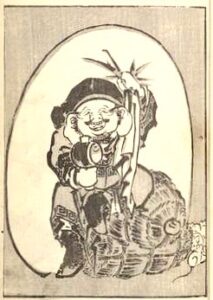
Illustration of Dai-koku–ten, 大黒天, Great-black; print by Hoku-sai Katsu-shika, 北斎葛飾, North-abstain Kudzu-esteem, Tōkyō (Edo) 1760–1849. Note the man-ji, 卍, 万字, ten thousand-lightning pattern along the edges of his garments.
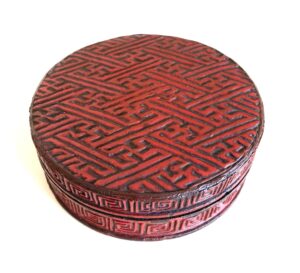
Kō-gō, 香合, incense-gather, vermilion-lacquered, covered container, with impressed pattern of kaminari, 雷, lightning. Note the man-ji, 卍, 万字, ten thousand-lightning pattern along the edge of the container.
The pattern of interlocking man-ji, 卍, is an ancient symbol of creation, combining the aspects of In and Yō and turning like the heavens. The pattern is also identified with the warrior monk Ben-kei, 弁慶, Distinguished-joy; diam. 1.8 sun kujira-jaku.
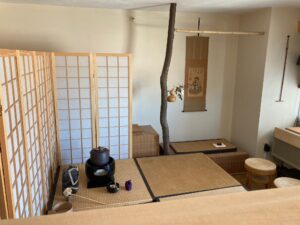
Garandō, with utensils for the Tea presentation called ‘Naka-oki’, 中置, Middle-place, with the furo placed in the middle of the tatami.
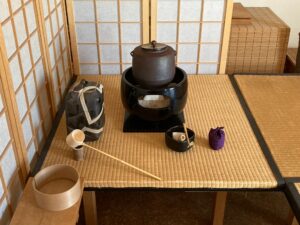
Arrangement of utensils for the Tea presentation called ‘Naka-oki’, Middle-place, for the location of the furo.
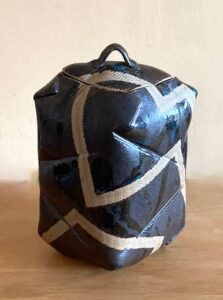
Mizu-sashi, 水指, water-indicate, lozenge-shaped stoneware vessel, with black glaze and unglazed ‘lightning bolts’; H. 9.5 sun kane-jaku, by Makoto Ya-be, 誠矢部, Truth Arrow-guild, Boxford, Mass.
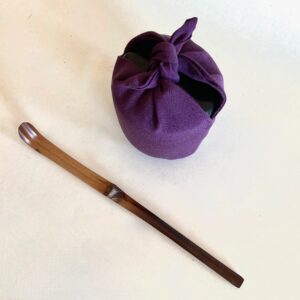
Rikyū-gata chū-natsume, 利休型中棗, Rikyū-style middle-jujube, tea container, wrapped in an Ō-tsu bukuro, 大津袋, Great-port bag, purple silk crêpe, by Kame-i Shō-sai, 亀井昭斉, Turtle-well Bright-equal. The bag is modeled on the ancient rice bag familiar to that of the Ōtsu area of Mai-bara, 米原, Rice-fields. Izumo Taisha is dedicated to the god of rice, Daikoku, who is usually depicted with rice bales.
Cha-shaku, 茶杓, tea-scoop, susu-dake, 煤竹, smoked-bamboo, with naka-bushi, 中節, middle node, reversed; L. 6 sun kane-jaku. I finished the chashaku in Cha-sen-mura, 茶筅村, Tea-whisk village, near Nara. Part of the visit to see the making of whisks, our group of Midorikai students of Urasenke was to finish pre-bent blank tea scoops. For this October’s Tea presentation, I have given the chashaku the name ‘Takara no tsuchi’, 宝の槌, Treasure ’s Mallet, in honor of Daikoku and his mallet that hammers out treasures, such as tea.
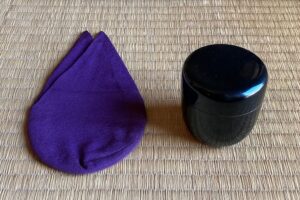
The natsume, like all tea containers, is identified with the Eki-kyō, 易経, Change-sutra, trigram, ☳, Shin, 震, Tremble, thunder and lightning.
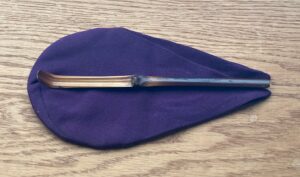
A chashaku placed on an Ōtsu bukuro, showing their equal length of 6 sun kane-jaku. When not wrapped around the Rikyu-gata chūnatsume, the bag is folded in half, which is in accord with the naka-bushi chashaku that is usually used with the Ōtsu bukuro.
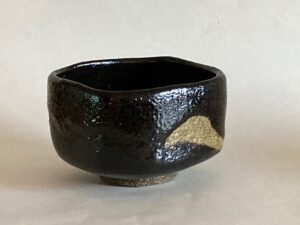
Four-sided cha-wan, 茶碗, tea-bowl, with kuro, 黒, black, glaze with un-glazed area, named ‘Masu’, 升, (box measure); h. 2.5 sun kane-jaku, by I-tō Kei-raku, 伊東桂楽, That-east Katsura-pleasure. Copy of masu chawan by Raku Dō-nyū, 楽道入, Pleasure Way-enter, called Nonkō, のんこう. The masu is used to measure rice, and other foods. Rikyū had a preferred maker of raku bowls, Chō-ji-rō, 長次郎, Long-next-son, who made seven bowls for Rikyū. Two bowls had similar names, one was called ‘O-guro’, 小黒, Small-black and the other was named ‘Ō-guro’, 大黒, Great-black, which may also be read dai-koku, suggesting the deity Daikoku.
With regards to the origin of Daikoku, who was originally known as the deity Mahā-kāla, Big-black, there is the Bijli Mahadev temple, which is dedicated to Shiva, is located in Kashawri village, Kullu Valley, Himachal Pradesh, India. Shiva is another manifestation of Mahākāla. It is believed that the sacred Shiva lingam is struck by lightning every twelve years. The lingam represents an early form of the phallic nature of Daikoku as a god of fertility.
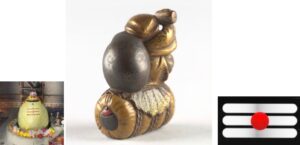
Left: the lingam at Bijli Mahadev temple repaired and reformed of butter. Note its form is similar to the ‘hō-ju’, 宝珠, treasure-jewel, like those on the ends of the kome-dawara, 米俵, rice-bales of Daikokuten. Note the three lines on the lingam that resemble the trigram, ☰, Ken, which is identified with Heaven.
Center: ne-tsuke, 根付, root-attach, figure of Daikoku on a rice bale adorned with a hōju (back view).
Right: Shiv tikla: three horizontal lines with a central red mark is one of the sacred marks of Shiva. The sign may evoke the three lines of the trigram Ken, with a moving center line perhaps identified with the change of line from Yō, 陽, Yang, positive to In, 陰, Yin, negative.
The Northwest is identified with two of the 12 signs of the Asian zodiac: Inu, 戌, Dog, and I, 亥, Boar. These signs are combined to create the trigram, ☰, Ken, inui, 乾, Heaven. This is most appropriate as the location of Amida.
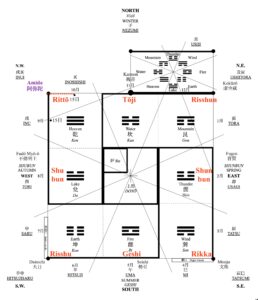
Diagram of a yo-jō-han, 四畳半, four-mat-half, cha-shitsu, 茶室, tea-room, showing various aspects of Japanese culture and Buddhism. In the upper right corner is the location of the fu-ro, 風炉, wind-hearth, and other Tea utensils. The area is under the protection of A-mi-da Nyo-rai, 阿弥陀如来, Praise-increase-steep Like-become, the Buddha of Compassion.
Amida is honored especially in accord with the full moon, which is on the night of the 15th day. The yojōhan is identified with the solar and lunar calendar, and the northwest is identified with the lunar 9th and 10th lunar months. The influence of the lunar 9th and 10th months cross at the center of the half tatami, which is protected by Amida. By placing the furo directly in the center, the incense and the entire Tea presentation may be dedicated to Amida. Incense is placed in every furo, prior to the Tea presentation.
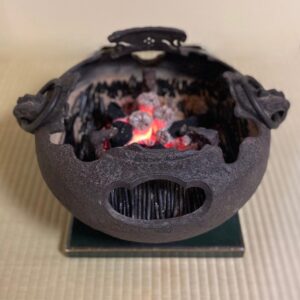
In the tenth lunar month, Urasenke uses the broken down ‘yatsure bu-ro’, 窶れ風炉, timeworn wind-hearth. This style of furo was originally used in a temple, therefore it is large. The broken down nature of the furo left it unsuitable for temple use, therefore it was adapted for use in the Tearoom.
The large, iron, treasured temple kama was, in part, responsible for the creation of the sunken ro, 炉, hearth. Its large structure of the furo prevented its standard furo placement, so it is a standard for Nakaoki tea presentations.
The surface of the ash bed is shaped into the ni-mon-ji, 二文字, two-letter-character, is covered with black wara-bai, 藁灰, straw-ash, made of rice straw stems. The black edazumi is in harmony with this weathered decline of autumn.
The yatsure-buro is essentially a large open bowl that is usually black. With its ash bed covered in black wara-bai, 藁灰, straw-ash, the entire impression is that of a bag that has burst open, revealing its treasures within. Perhaps the furo represents the great bag, yabure-bukuro, 破袋, broken-bag, of Daikoku.
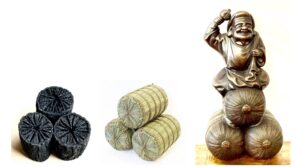
Three pieces of charcoal: sumi, 炭, charcoal, used as shita-bi, 下火, down-fire, in the hearth. Three kome-dawara, 米俵, rice-bales, each wrapped in straw. Note the similarity of forms. It is as though the rice bales were burned and the straw became wara-bai. Figure of Daikokuten standing atop three bales of rice. Note the design of hō-ju, 宝珠, treasure-jewel, at the ends of the rice bales. The hōju is symbolically combined water and fire – In and Yō, 陰 and 陽, Yin and Yang, negative and positive.
It is said that the furo placed in the middle of the tatami is to provide additional warmth for the guests. This is in anticipation of the opening of the ro, which provides a great deal of heat. However, when one does not have a ro, the furo continues to be used and is returned to its original location on the side. There are deeper meanings. The rice straw charcoal may have some associations with mukaeri-bi, 迎えり火, welcome-fire, and okuribi, 送火, farewell-fire, of rites such as O-bon, お盆, Hon.-tray, when departed spirits are welcome home and return to paradise.
The phrase ‘Kami-mukae Matsuri’, 神迎祭, God-welcome Festival, draws a seasonal link between the autumn festival in Izumo and the harvest of ripe, yellow yu-zu, 柚子, citrus-of, (Citrus ichangensis x C. reticulata, which both occur in November. Ripe yuzu are offered to the Kami. The festival evokes a specific time of year in Japan—a period of both mythic significance and seasonal bounty.
For further study, see also: Nakaoki Collection

